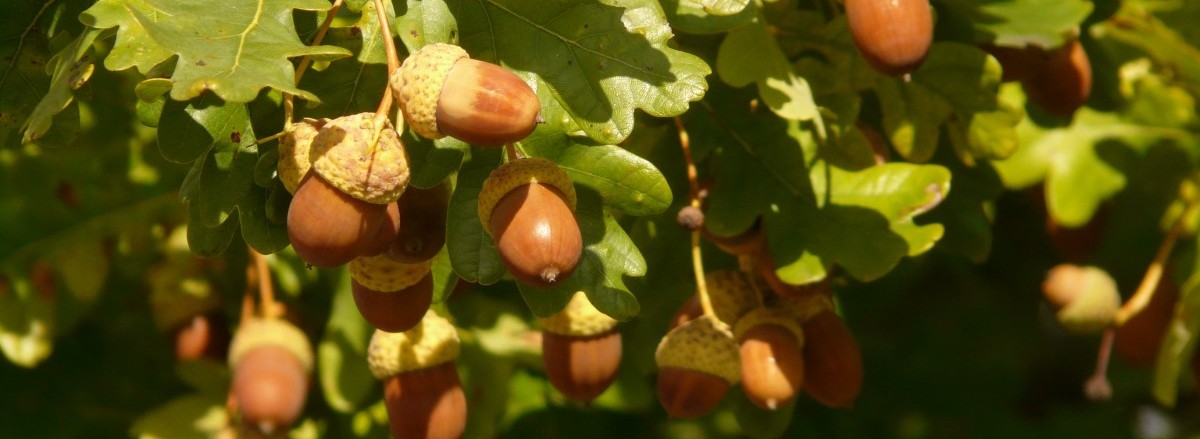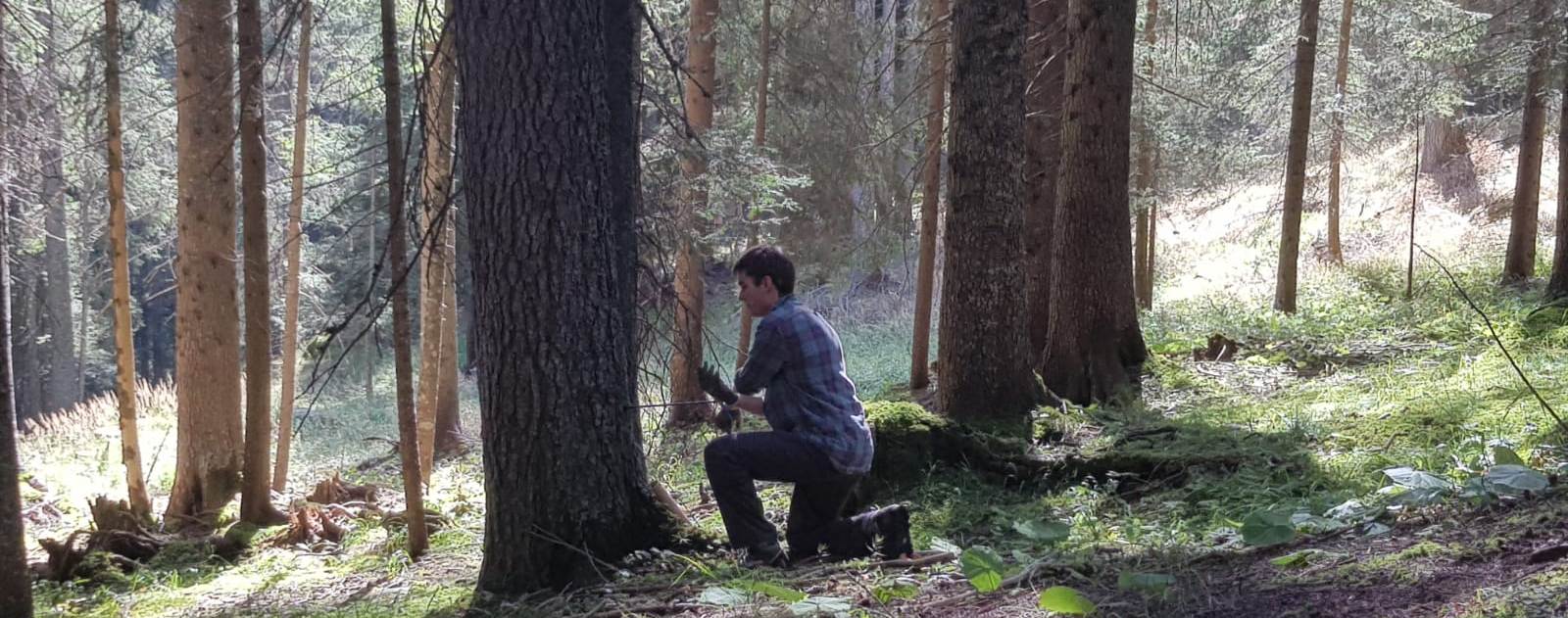Research

Seed masting ecology
Masting is the synchronous and highly variable production of seeds and fruits, and is a characteristic reproductive strategy in many grass and woody species (Fernández-Martínez, 2019; Hacket-Pain, 2021; Pesendorfer et al., 2021). Most plants do not produce regular annual seed crops, but switch between years of bumper seed crops (known as "mast years") and years with low seed production. Intriguingly, these bumper crops occur simultaneously in plants living alongside each other, but the synchronisation can also extend across hundreds of kilometres (Vacchiano et al., 2017; Ascoli et al. 2020; Bogdziewicz et al. 2021a; Bogdziewicz et al. 2023; Bogdziewicz et al. 2024).
A series of papers has focused on understanding patterns and drivers of masting in two of the most widespread tree species in Europe - European Beech and Norway Spruce. Over the last decade we have drawn together published and previously unpublished datasets to develop the largest open-access masting database (MASTREE+, Hacket-Pain et al., 2022), as part of the MAST-NET project. MASTREE+ contains >80,000 records of plant reproduction from >1000 species, with the earliest datasets extending back to 1677. Analysis of this dataset has revealed distinct spatial structures in masting patterns, including the occasional occurrence of continent-wide mast years (i.e. simultaneous high seed production across Europe) (Vacchiano et al. 2017; Ascoli et al., 2017b; Bogdziewicz et al. 2023). We are currently using this dataset to understand how masting varies between and within species (Foest et al., in revision). For example, our work shows that the evolution of masting is linked to life-history strategies promoting long-lifespans (i.e. high wood density) (Journé, Hacket-Pain & Bogdziewicz, 2023). A summary of that work is included in this bog post. Through a collaboration between the MAST-NET project and the MASTIF project we have contributed to work revealing how investment in reproduction varies between dramatically between species and along climate gradients (Journé et al., 2022; Qiu et al., 2022).
A major motivation of our current research is to better understand the response of masting to environmental change (Hacket-Pain and Bogdziewicz, 2021). We have shown that climate warming is associated with a "breakdown" in masting in UK beech trees (Bogdziewicz et al., 2020b; Bogdziewicz et al., 2021b), which has led to a dramatic decline in viable seed production in this species (Bogdziewicz et al.,2023). New research shows that a dampening of interannual variability in seed production in beech is occuring across Europe in association with warming summer temperatures (Foest et al., 2024). Future research will examine whether these changes are occurring in other species and regions, testing predictions from the General Model of Masting (Bogdziewicz... & Hacket-Pain, 2024) and what this means for forest regeneration under climate change. A summary of this work was featured on BBC AutumnWatch.
Recently, we have been working with policy-makers and practitioners to understand how we can use knowledge of masting to help secure the native tree seed supply we need for the expansion of woodland in the UK. Woodland expansion requires seeds, but the unreliable supply that results from masting creates major challenges. As part of work initiated during a Treescapes Fellowship, funded by the UKRI and Defra, and working closely with collegeaues at BOKU in Vienna, we are developing tools to enable "mast forecasting" (Journé et al., 2023; Oberklammer et al., In Prep), which will allow the forecasting of bumper and failure seed crops up to one year in advance.

Forest response to climate change
Changes in climate are causing significant changes in the functioning, composition and structure of Europe’s forests. For example, increased temperatures and drought stress, coupled with changes in atmospheric CO2, nutrient availability, disturbance dynamics and management are resulting in changes in the productivity of forests, with implications for carbon storage and the future of terrestrial carbon sink.
This research theme uses tree ring chronologies to create to create long time-series of tree and forest growth. Long-term changes in growth are linked to decadal patterns in climate (Hacket-Pain and Friend 2017; Dorado-Liñán et al., 2022; Martinez del Castillo et al., 2022), inter-annual variations in growth are used to assess the sensitivity of growth to seasonal climate variability (Muffler et al., 2020), and the response of growth to extreme climate events is used to quantify the sensitivity of forests to drought events (Hacket-Pain et al. 2017; Castagneri et al. 2022). Current research is focused on developing a distribution-wide network of tree ring chronologies (Hacket-Pain et al., 2018; Dorado-Liñán et al., 2022). We are using this network of tree ring chronologies to understand how the sensitivity of these species to drought and other climatic driver of growth varies within this species geographic distribution (Klesse et al., in review). This includes the effect of between-tree competition, with implications for how we can manage forest ecosystems to mitigate the impacts of future increases in drought frequency and severity (Castagneri et al., 2022).
However, forest responses to global environmental change are dependent not only the response of tree growth, but also tree mortality, and reproduction and regeneration. Work has included studying the mortality and recruitment in Alpine beech forests after fire disturbance (Maringer et al., 2019; Maringer et al., 2021), and a large-scale study to establish the links between climate teleconnections, drought, fire and seed production in North American boreal forests (Ascoli et al., 2019). You can read more about the links between climate, wildfire and seed production in boreal forest on The Journal of Ecology blog

Understanding trade-offs between tree growth and reproduction
This work draws together my interests in masting and tree-rings. Tree growth is the primary process by which carbon fixed by photosynthesis is sequestered in forest ecosystems, but the supply of carbon from photosynthesis is not the only factor that controls tree growth (and productivity more generally). For example, the allocation of available resources plays a key role. The production of flowers, pollen, fruits and seeds all require significant investment of resources, which can result in a "trade-off" with growth. Consequently, year-to-year variation in allocation to reproduction (masting) is an important control on tree growth, and years with high investment in reproduction are associated with reduced growth (Hacket-Pain et al. 2017; Hadad et al., 2021). Furthermore, as reproduction is influenced by weather conditions in various biologically relevant seasonal windows (Vacchiano et al. 2017, Journe et al., 2023), the interplay with reproduction creates important indirect mechanisms by which climate can influence growth (Hacket-Pain et al. 2018). Research has focused on European beech, but the next step is to investigate these dynamics for other species (Hacket-Pain et al., 2019; Hadad et al, 2021). Intriguingly, while trade-offs are strong in beech and several species of conifer (Hadad et al., In Prep), we found no evidence of trade-offs in oaks growing in eastern North America, despite the presence of strong masting (Patterson et al., 2023).
Where masting signals are contained in tree-ring chronologies, they present the possibility to reconstruct masting chronologies using dendrochronological technqiues (Hadad et al., 2021; Hacket-Pain et al. In Review). This has the potential provide a multicentury understanding of baseline variability in masting - for example putting the recent masting breakdown into a long-term context. We are working on this in the iconic Patagonian conifer Araucaria araucana, in a project funded originally by The Royal Society, and we are also exploring wood anatomical signals linked in masting in European tree species, working with colleagues in Italy and Germany.
Research groups
Research grants
Long-term drivers of broadleaved woodland change (Lady Park Wood)
ECOLOGICAL CONTINUITY TRUST (UK), RAMBLERS HOLIDAYS CHARITABLE TRUST
February 2025 - June 2026
Seeds for Treescapes
NATURAL ENVIRONMENT RESEARCH COUNCIL
January 2023 - September 2023
Individual variation in masting traits
ADAM MICKIEWICZ UNIVERSITY (POLAND)
April 2022 - September 2023
Assessing and predicting variation in oak acorn production in response to climate change
BRITISH COUNCIL FRANCE (FRANCE)
January 2022 - December 2023
Treeline advances in a changing climate: understanding how climate affects reproduction and early life stages in Black spruce
UK RESEARCH AND INNOVATION
April 2021 - March 2022
MonkeyPuzzle: Reconstructing mast events and climate in Patagonia using Araucaria araucana tree rings
ROYAL SOCIETY
December 2019 - December 2022
MAST-NET: masting responses to climate change and impacts on ecosystems
NATURAL ENVIRONMENT RESEARCH COUNCIL
December 2018 - June 2022
Untangling climate drivers of wildfire in the Northwest Territories
DEPARTMENT FOR BUSINESS, ENERGY AND INDUSTRIAL STRATEGY (BEIS) (UK)
March 2018 - February 2019